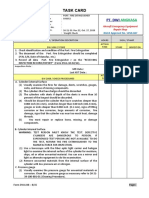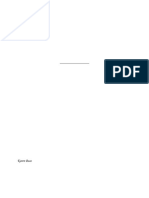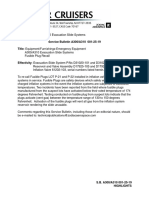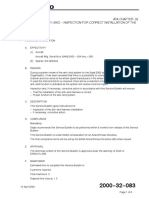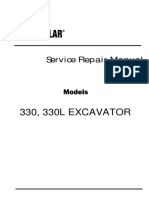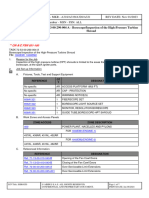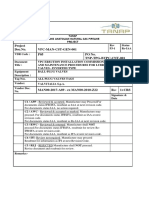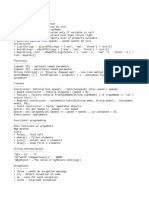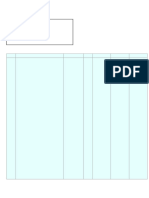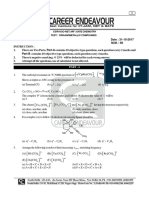MTC Port. Fire Extingusiher Pn. 898052 (HST & Refill)
MTC Port. Fire Extingusiher Pn. 898052 (HST & Refill)
Uploaded by
Moch Fahrizal FirdausCopyright:
Available Formats
MTC Port. Fire Extingusiher Pn. 898052 (HST & Refill)
MTC Port. Fire Extingusiher Pn. 898052 (HST & Refill)
Uploaded by
Moch Fahrizal FirdausOriginal Title
Copyright
Available Formats
Share this document
Did you find this document useful?
Is this content inappropriate?
Copyright:
Available Formats
MTC Port. Fire Extingusiher Pn. 898052 (HST & Refill)
MTC Port. Fire Extingusiher Pn. 898052 (HST & Refill)
Uploaded by
Moch Fahrizal FirdausCopyright:
Available Formats
TASK CARD
Part Name : PORT. FIREX CMM ATA No. : 26-21-39 Rev.22. 10/2020
Part Number : 898052 & NFPA-10. Ed. 2013
Serial Number : Workscope : Inspection & Test
PT. DWI ANGKASA
DGCA Approval Cust./WO No. : HST
No. 145D-667 Internal WO : Refill
OPERATION NO / OPERATION DESCRIPTION HOURS SIGN / STAMP
ACTUAL
DW 1000 / STORE STORE INSPECTOR
TIME
1. Check identification and condition of the Port. Fire Extinguisher
2. The document of the Port. Fire Extinguisher should be completed
(P/N, S/N, Date of Manufac. etc.)
3. Record all data Port. Fire Extinguisher r on the "RECEIVING
INSPECTION RECORD/REPORT" (Form DWA 10-02/14).
Inspection Note :
Mfr Date :
Last HST Date :
ACTUAL
DW 2000 / CHECK PROCEDURES MECHANIC INSPECTOR
TIME
A. Cylinder External Surface
(1) Visually examine the firex for damage, dents, scratches, gouges,
nicks, and loose of missing components.
(2) The cylinders that have bulges should be discarded.
(3) The cylinders with dents if depth of the dents is more than 10
percent of the longest should be discarded.
(4) Should be discard the cylinder that have scratches deeper than
0.004 inch (0.1 mm), scratches longer than 4.00 inch (101.6 mm),
gouges or nicks deeper than 0.004 inch (0.1 mm), signs of fitting
corrosion or line corrosion, large amounts of corrosion, fire
damage, signs that the cylinder was near too much heat, damage
threads.
B. Cylinder Internal Surface
(1) Use a borescope with the fiber optic light carrier and halogen
light to examine the internal surface of the cylinder for moisture,
chips, oil or other unwanted material. You can use a mirror and
light as alternate equipment to do the examination.
(2) Remove unwanted materials from the internal surface of the
cylinder with low pressure air or nitrogen.
C. Pressure gauge
(1) Visually examine the pressure gauge for unwanted materials or
corrosion.
(2) Visually examine the pressure gauge for damage. Replace a
damage pressure gauge
D. Valve Assembly
(1) Visually examine the valve assembly for crack or damaged
threads. Discard the valve assembly, if the it has damage.
(2) visually examine the neck seal (IPL Fig. 1 and !B, 40), (IPL Fig. 1A,
80) for damage. Replace a damage neck seal (refer to
DISASSEMBLY and ASSEMBLY).
Form DWA 08 – 8/15 Page : 1 of 7
TASK CARD
Part Name : PORT. FIREX CMM ATA No. : 26-21-39 Rev.22. 10/2020
Part Number : 898052 & NFPA-10. Ed. 2013
Serial Number : Workscope : Inspection & Test
PT. DWI ANGKASA
DGCA Approval Cust./WO No. : HST
No. 145D-667 Internal WO : Refill
E. Hose
(1) Visually examine the hose for damage or blockage. Discard a hose
or nozzle with damage.
(2) Clean or replace a nozzle with blockage
F. Siphon Tube and Coupling Assembly
(1) Visually examine the siphon tube and coupling assembly for
damage or blockage. Discard the valve assembly, if the siphon
tube and coupling assembly has damage.
(2) Clean or replace siphon assembly with blockage.
H. Nameplate and Label
(1) Visually examine the nameplate and hydro proof pressure label.
Make sure you can read all the data.
(2) Replace damaged nameplate or label (ref. to Task 26-21-39-300-
801-A01. Repair Procedures).
ACTUAL
DW 3000 / DISASSEMBLY PROCEDURES MECHANIC INSPECTOR
TIME
NOTE: Refer to IPL fig.1B for the location of the Parts.
(1) Secure the firex in the padded vise or other suitable holding
fixture. The fire extinguisher must be in vertical position.
(2) Remove the pull-tite seal (5) and pull-out (10) from the valve
assembly (15). Discard the pull-tite seal. Keep the pull-out pin (10)
for assembly.
(3) Connect the recharge adapter (878040) to the valve assembly
(15).
(4) Use the nozzle retaining clip (65) to keep the recharge adapter in
position.
WARNING: MAKE SURE THAT COMPONENTS AND FITTINGS ARE
CORRECTLY TORQUED SECURE ALL FLEXIBLE LINES. MAKE
SURE THAT THE FILL AREA HAS A GOOD AIR FLOW, AND
FUMES AND PRESSURE ARE BLED TO THE ATMOSPHERE.
DO NO LET THE EXTINGUISHING AGENT TOUCH YOY SKIN.
IF THE PRESSURE IS ACCIDENTALLY RELEASED FROM THE
FIRE EXTINGUISHER, IT IS DANGEROUS TO PERSONS AND
CAN CAUSE DAMAGE TO EQUIPMENT.
(5) Make sure all recharge stand and supply cylinder valves are
closed.
(6) Use your hand or a clamp to hold the lever and handle of the
valve assembly (15) in the operate (down) position.
(7) Open recharge stand valve and fully remove the contents of the
fire extinguisher.
(8) Close recharge stand valve, when the fire extinguisher is empty.
(9) Keep the lever and handle in the operate (down) position while
you turn the valve assembly (15) counterclockwise to remove it
from the cylinder (80).
Form DWA 08 – 8/15 Page : 2 of 7
TASK CARD
Part Name : PORT. FIREX CMM ATA No. : 26-21-39 Rev.22. 10/2020
Part Number : 898052 & NFPA-10. Ed. 2013
Serial Number : Workscope : Inspection & Test
PT. DWI ANGKASA
DGCA Approval Cust./WO No. : HST
No. 145D-667 Internal WO : Refill
(10) Remove and discard the neck seal (40)
(11) Remove the gauge retaining clip (50) from the valve assembly
(15).
(12) Remove the O-ring (55) from the valve assembly (15). Discard the
O-ring.
(13) Connect the vacuum pump to the cylinder (80) to remove any
liquid extinguishing agent that remains from the cylinder (80). Let
the pump operate for approximately five minutes.
(14) Disconnect the pump from the cylinder (80)
ACTUAL
DW 4000 / HYDROSTATIC TEST PROCEDURES MECHANIC INSPECTOR
TIME
(1) Install the cylinder in the test setup shown in CGA Pamphlet C1
(2) Open the water supply and fill the cylinder with water through
the open test adapter in the cylinder neck. When the water
comes out of the test adapter, all air has been removed from the
cylinder.
(3) Fully tighten the test adapter
(4) Turn off the water supply
(5) Attach the pressure line of the test setup to the test adapter in
the cylinder neck.
(6) Pressurize the cylinder to the test pressure 300 Psig (2069 kPa)
(7) Visually examine the cylinder there must be no distortion or
leakage and test pressure must not decrease.
(8) Release the air pressure and remove the cylinder from the test
setup
(9) Use black marking ink and a rubber stamp to write the date of
hydrostatic and inspector initials on the hydro proof pressure
label (IPL fig1A, 106), or IPL fig 1B, 76).
Inspection Note : Distortion Leakage
Pressure test up to 300 Psig result
No Distortion No Leakage
ACTUAL
DW 5000 / CLEANING PROCEDURES MECHANIC INSPECTOR
TIME
A. Metal Parts
1. Clean Metal parts with alcohol or an equivalent cleaning solvent.
WARNING: When you use compressed air to clean or dry parts, make
sure that the pressure is not more than 30 pounds. Do not
point the airstream at personnel or light objects. Put on
googles or a face shield to protect your eyes.
2. Dry the parts with low pressure or air nitrogen. You can also use a
low-lint cloth to dry the parts.
B. Non-Metal Parts
Clean parts that are not metal with a clean, dry low-lint cloth.
Form DWA 08 – 8/15 Page : 3 of 7
TASK CARD
Part Name : PORT. FIREX CMM ATA No. : 26-21-39 Rev.22. 10/2020
Part Number : 898052 & NFPA-10. Ed. 2013
Serial Number : Workscope : Inspection & Test
PT. DWI ANGKASA
DGCA Approval Cust./WO No. : HST
No. 145D-667 Internal WO : Refill
ACTUAL
DW 6000 / ASSEMBLY MECHANIC INSPECTOR
TIME
WARNING : PACKING LUBRICANT CAN CAUSE IRRIITATION OF YOUR SKIN
OR EYES. BEFORE YOU USE THE LUBRICANT, GET THE
SAFETY DATA SHEET FROM THE MAUFACTURE OR SUPPLIER
OF THE MATERIAL AND READ IT CAREFULLY. IF THE
LUBRICANT GETS IN YOUR EYES, IMMEDIATELY FLUSH THEM
WITH WATER FOR A MINIMUM OF 15 MINUTES WHILE YOU
HOLD THE EYELIDS OPEN. IF LUBRICANT GETS ON YOUR
SKIN, WASH THE SKIN WITH SOAP AND WATER. IF THE EYE
OR SKIN IRRITATION CONTINUES, GET MEDICAL AID.
(1) With the flat surface of the neck seal (40) pointed to the valve
assembly (15), install the neck seal (40) over the threads of the
valve assembly (15). Do not apply any seal lubricant on the neck
seal (40) or threads of the valve assembly (15).
(2) Move the neck seal (40) until it is in the area above the threads.
(3) Install the valve assembly (15) in the cylinder (80).
(4) Use torque adapter (WT-03015) to tighten the valve assembly
(15) between 135 and 140 Ibf-inch (15.26 and 16.82 N-m). After
you torque the valve assembly, the centreline of the gauge hole
aligned with the approximate centreline of the nameplate (75).
(5) Put a thin layer of seal lubricant on the gauge O-ring (55).
(6) Install the O-ring (55) over the stem of the pressure gauge (45).
(7) Push the pressure gauge (45) into the gauge hole in the valve
assembly (15).
(8) Push the retaining clip (50) into the slot above the gauge guard
in the valve assembly (15).
(9) Install the recharge adapter (878040) on the valve assembly (15).
(10) Use the nozzle retaining clip (65) to keep the recharge adapter in
position.
(11) Install the empty fire extinguisher in the fill fixture. Close and
latch the clamp to secure the cylinder in the fixture.
(12) Use the fixture lever to keep the valve lever in the operate
(down) position.
(13) Put the fill fixture on the scale (Refer to Figure 7002).
(14) Apply a thin layer of seal lubricant of the nozzle O-ring (70).
(15) Push the nozzle (60) into the discharge outlet of the valve
assembly (15) until it is fully against the outlet surface.
(16) Install the nozzle retaining-clip (65) in the slot on the side of the
valve assembly (15).
(17) Install the pull-out pin (10) through the holes in the lever and
handle.
(18) Install the pull-tite seal (5) through the loop of the pull-out pin
(10) and the gap beneath the top lever and lopped under the
Form DWA 08 – 8/15 Page : 4 of 7
TASK CARD
Part Name : PORT. FIREX CMM ATA No. : 26-21-39 Rev.22. 10/2020
Part Number : 898052 & NFPA-10. Ed. 2013
Serial Number : Workscope : Inspection & Test
PT. DWI ANGKASA
DGCA Approval Cust./WO No. : HST
No. 145D-667 Internal WO : Refill
handle (Refer to Figure 7001).
(19) Wait approximately four hours before you do the halogen leak
seal test.
ACTUAL
DW 7000 / CHARGING MECHANIC INSPECTOR
TIME
(1) Only those agents specified on the nameplate or agents proven to
have equal chemical composition, physical characteristics, and
fire-extinguishing capabilities shall be used.
(2) Agents listed specifically for use whit that fire extinguisher shall
be considered to meet these requirements.
(3) Halogenated Agent. Halogenated agent fire extinguisher shall be
charge with only the type and weight of agent specified on the
nameplate.
ACTUAL
DW 8000 / LEAK TEST MECHANIC INSPECTOR
TIME
(1) Turn the fire extinguisher until the area where you think there is a
leak is at the highest point.
(2) Use the detector probe the to find if the air in the test area
contains halon.
(3) Do the leak test on all areas of the fire extinguisher.
CAUTION : DO NOT TORQUE THE VALVE ASSEMBLY TO STOP A LEAK.
YOU CAN CAUSE DAMAGE TO THE FIRE EXTINGUISHER
COMPONENTS OR THE SEALING SURFACES.
ACTUAL
DW 9000 / FIT AND CLEARANCE MECHANIC INSPECTOR
TIME
`
Torque Values
IPL Fig.
Name Torque Value Actual
Item Number Part No
1-20A 420044 Siphon Tube/ 20 Ibf-inch
Coupling assembly (2.26 N-m)
1A-14 440086 Valve Assembly 135 to 140 Ibf-
inch (15.26 to
15.82 N-m)
1A-55 420011 Siphon Tube/ 20 Ibf-inch
Coupling assembly (2.26 N-m)
1A-55A 320145 Siphon Tube/ 20 Ibf-inch
Coupling assembly (2.26 N-m)
1B-15 266061 Valve Assembly 135 to 140 Ibf-
inch (15.26 to
15.82 N-m)
Form DWA 08 – 8/15 Page : 5 of 7
TASK CARD
Part Name : PORT. FIREX CMM ATA No. : 26-21-39 Rev.22. 10/2020
Part Number : 898052 & NFPA-10. Ed. 2013
Serial Number : Workscope : Inspection & Test
PT. DWI ANGKASA
DGCA Approval Cust./WO No. : HST
No. 145D-667 Internal WO : Refill
ACTUAL
DW 10000 / PAINTING MECHANIC INSPECTOR
TIME
A. Surface Preparation:
1. Cylinders requiring a complete repainting process should be
phosphate coated before paint application.
2. Cylinders requiring a spot repainting process should be lightly
sanded around the spot repair areas.
3. Refer to the cleaning section and clean the exterior surface of
the cylinder to remove any contamination.
4. Remove the identification decal, and label or install masking
tape over these items to protect them from the primer and
paint over spray.
B. Primer Application :
1. Thread the cylinder hanger into the cylinder.
2. Mix the light grey primer & catalyst using the instructions
supplied by the manufacturer.
3. Filter and spray the catalyzed paint onto the cylinder surface
with a spray gun using the instructions supplied by the
manufacturer.
4. Allow the cylinder to air dry 15 to 20 minutes before the
application of the paint.
C. Paint Application :
1. Thread the cylinder hanger into the cylinder.
2. Mix the paint and catalyst using the instructions supplied by the
manufacturer.
3. Filter and spray the catalyzed paint onto the cylinder surface
with a spray gun using the instructions supplied by the
manufacturer.
4. Allow the paint to cool & stabilize for 24 hours before placing
the cylinder into service.
ACTUAL
DW 11000 / WEIGHT CHECK MECHANIC INSPECTOR
TIME
1. Make sure that the weighing scale on the zero scale
2. Place the Firex Halon on the weighing scale.
3. Record the results of actual weight on the record book.
4. Weight of Charged Assembly are 1.59 to 1.73 Kg.
Inspection Note :
Total Weight of Port. Fire Extinguisher = . . . . . . . . . . . Kg / . . . . . . . . . . Lbs.
ACTUAL
DW 12000 / FINAL INSPECTION INSPECTOR
TIME
1. Inspect all of the step operation and finally results of the Port.
Fire Extinguisher and write on the stripping report.
2. Issued the ARC document for legalize of the Port. Fire
Extinguisher that has been carried out accordance with
Form DWA 08 – 8/15 Page : 6 of 7
TASK CARD
Part Name : PORT. FIREX CMM ATA No. : 26-21-39 Rev.22. 10/2020
Part Number : 898052 & NFPA-10. Ed. 2013
Serial Number : Workscope : Inspection & Test
PT. DWI ANGKASA
DGCA Approval Cust./WO No. : HST
No. 145D-667 Internal WO : Refill
requirements of the Indonesia Civil Safety Regulation Part 145.
ACTUAL
DW 13000 / PACKAGING STORE INSPECTOR
TIME
1. Stow the package Port. Fire Extinguisher and container assembly
in a clean, dry, free away from any heat source.
2. Stow package Port. Fire Extinguisher in an area at least equal to
package dimensions.
3. The Port. Fire Extinguisher package is dry clean and free from
other contaminations using materials that are not easy to cause
friction and impact in accordance with ATA-300 packaging.
Prepared by : Approved by :
Maintenance, Quality, Control
SUYONO HARTONO M
Form DWA 08 – 8/15 Page : 7 of 7
You might also like
- Letter To Collection AgencyDocument5 pagesLetter To Collection AgencyD Fields100% (39)
- FD-1600 Triplex Mud Pump User ManualDocument387 pagesFD-1600 Triplex Mud Pump User Manualfaishal hafizh77% (13)
- Bridge Resource Management Trai - Rexford PennDocument92 pagesBridge Resource Management Trai - Rexford PennJavier Walcott100% (1)
- Hydro Blowers - OPM-002 - A - JetFan 70 Operators ManualDocument29 pagesHydro Blowers - OPM-002 - A - JetFan 70 Operators ManualvinodNo ratings yet
- Evaporator Data Sheet - SKO0501049 Rev0Document10 pagesEvaporator Data Sheet - SKO0501049 Rev0chublackNo ratings yet
- Layover Inspection Schedule Issue 09 (A320-232)Document19 pagesLayover Inspection Schedule Issue 09 (A320-232)pankaj0% (1)
- 15PPM Ocd CM PDFDocument4 pages15PPM Ocd CM PDFTrần Quang Tuyên100% (1)
- 61 20Document12 pages61 20Miguel Condor100% (1)
- GEOGRAPHY IGCSE Riassunti PP 4-46, 52-151Document28 pagesGEOGRAPHY IGCSE Riassunti PP 4-46, 52-151tommaso100% (1)
- Cat FiltersDocument96 pagesCat FiltersGaming Bebas100% (2)
- MTC Port. Fire Extinguisher 466040, 466090, 898052Document4 pagesMTC Port. Fire Extinguisher 466040, 466090, 898052Moch Fahrizal Firdaus100% (1)
- 73-10-06 Fuel Drain Valve - Maintenance PracticesDocument5 pages73-10-06 Fuel Drain Valve - Maintenance PracticesAndres GuerreroNo ratings yet
- WEFIC WELLHEAD Rig Book KOM-103013-03 REV 0Document258 pagesWEFIC WELLHEAD Rig Book KOM-103013-03 REV 0tongsabaiNo ratings yet
- 74-20-00 Igniters and Ignition Cables - Maintenance PracticesDocument15 pages74-20-00 Igniters and Ignition Cables - Maintenance PracticesAndres GuerreroNo ratings yet
- Final Inspection Report 12-E-101 ADocument4 pagesFinal Inspection Report 12-E-101 AYudi Ibnu ChannelNo ratings yet
- Tws SovDocument5 pagesTws SovKalaivani MurugesanNo ratings yet
- Stripper PackDocument111 pagesStripper PackRicardo Antonio Sierralta NavaNo ratings yet
- Ignition System - Inspection Check PDFDocument4 pagesIgnition System - Inspection Check PDFMark Evan SalutinNo ratings yet
- Ignition System - Inspection Check PDFDocument4 pagesIgnition System - Inspection Check PDFMark Evan SalutinNo ratings yet
- FAA-2016-9392-0022_attachment_8Document10 pagesFAA-2016-9392-0022_attachment_8gsheetslogisticsNo ratings yet
- T 24-33-01-900-801-Removal Installation of The Apu Starter-GeneratoDocument11 pagesT 24-33-01-900-801-Removal Installation of The Apu Starter-Generatosahag9607No ratings yet
- Oil Processing Department - South South Process Units: 2023 Shutdown Work List 4A CDU (UNIT # 22 and 24)Document78 pagesOil Processing Department - South South Process Units: 2023 Shutdown Work List 4A CDU (UNIT # 22 and 24)Salem AliNo ratings yet
- T 55-00-00-270-801-Ultrasonic Inspection For Stress Corrosion in StabDocument29 pagesT 55-00-00-270-801-Ultrasonic Inspection For Stress Corrosion in StabAldo Gibran Esquivel CarmonaNo ratings yet
- SD-010404-01 - Test Stump Operating ManualDocument15 pagesSD-010404-01 - Test Stump Operating ManualFam Escalante OnofreNo ratings yet
- MJR For 30M Maintenance Check of Check ValvesDocument9 pagesMJR For 30M Maintenance Check of Check Valvesxtremewhiz100% (1)
- 52 32 Convertible Namur Solenoid Valve Model 51424 51424Lw 51424is PDFDocument7 pages52 32 Convertible Namur Solenoid Valve Model 51424 51424Lw 51424is PDFysr3eeNo ratings yet
- Operation and Care Manual: Whip-Style Delivery SystemDocument60 pagesOperation and Care Manual: Whip-Style Delivery Systemgertony2011No ratings yet
- TTA R407C IOM - Apr 2016Document28 pagesTTA R407C IOM - Apr 2016hungstampNo ratings yet
- SB3 1 102Document6 pagesSB3 1 102jussmeeeNo ratings yet
- 3890137e Tech Spec Data Sheets 1556604052Document14 pages3890137e Tech Spec Data Sheets 1556604052Prakash AnnamalaiNo ratings yet
- Pressure Vessel High Pressure Stripper R0 Final Report R1Document5 pagesPressure Vessel High Pressure Stripper R0 Final Report R1AJ NugrohoNo ratings yet
- Ecodan Indoor EHPT20X-VM2HB ServiceDocument92 pagesEcodan Indoor EHPT20X-VM2HB ServiceEbi ZamaniNo ratings yet
- Pinion and Carrier Group - Disassemble - In-ChassisDocument4 pagesPinion and Carrier Group - Disassemble - In-ChassisNidya Wardah JuhanaNo ratings yet
- Caterpillar Cat 330B L EXCAVATOR (Prefix 1JS) Service Repair Manual (1JS00001 and Up)Document26 pagesCaterpillar Cat 330B L EXCAVATOR (Prefix 1JS) Service Repair Manual (1JS00001 and Up)kfm8seuuduNo ratings yet
- ML C 650 c65mm213Document6 pagesML C 650 c65mm213operacionesNo ratings yet
- Air Inlet and Exhaust SystemDocument73 pagesAir Inlet and Exhaust SystemDavid ShawNo ratings yet
- turb washDocument2 pagesturb washRaigarh BaseNo ratings yet
- SB_0768ADocument3 pagesSB_0768AGilberto Alan Treviño CuevasNo ratings yet
- APT Procedure VR300SDocument6 pagesAPT Procedure VR300Smatias dagostoNo ratings yet
- FAA 2020 0855 0005 - Attachment - 1Document6 pagesFAA 2020 0855 0005 - Attachment - 1Furkan DuruNo ratings yet
- ATR Removal of The Fuel Heater Inlet FilterDocument4 pagesATR Removal of The Fuel Heater Inlet FilterPradeep K sNo ratings yet
- Pfeiffer ActiveLine CMR 361 CMR 362 CMR 363 CMR 364 CMR 365 Capacitance Gauge Operating InstructionsDocument32 pagesPfeiffer ActiveLine CMR 361 CMR 362 CMR 363 CMR 364 CMR 365 Capacitance Gauge Operating Instructionsdbhansali57No ratings yet
- Piper SB1233CDocument5 pagesPiper SB1233Ccarontej1No ratings yet
- STOD-GEN-AED-0000-PR-DAT-0008 - Anaguid Test Separator Data SheetDocument6 pagesSTOD-GEN-AED-0000-PR-DAT-0008 - Anaguid Test Separator Data SheetAHMED AMIRANo ratings yet
- HPT Stage 1 Blades and Duct SegmentsDocument28 pagesHPT Stage 1 Blades and Duct SegmentsArabyAbdel Hamed Sadek100% (1)
- Layover Inspection Schedule Issue 06Document17 pagesLayover Inspection Schedule Issue 06Pankaj Khondge100% (1)
- Apv Valves Da3plus Atex GBDocument48 pagesApv Valves Da3plus Atex GBSimon MinneNo ratings yet
- CDU-A101-GP-010 Comissioning, Decomissioning of Finfan CoolersDocument12 pagesCDU-A101-GP-010 Comissioning, Decomissioning of Finfan Coolerssuleiman.ikelejiNo ratings yet
- RAUP-IOM (Rev.D)Document48 pagesRAUP-IOM (Rev.D)Thiraviam AyyappanNo ratings yet
- Campana WMA-1 TYCODocument4 pagesCampana WMA-1 TYCOsnonumNo ratings yet
- Atr Weak AreasDocument10 pagesAtr Weak AreasEngr. Nowsherwan AdilNo ratings yet
- NDTM Part 10Document73 pagesNDTM Part 10Sui Hing LamNo ratings yet
- Caterpillar Cat 330 TRACK-TYPE EXCAVATOR (Prefix 6SK) Service Repair Manual (6SK00001 and Up)Document24 pagesCaterpillar Cat 330 TRACK-TYPE EXCAVATOR (Prefix 6SK) Service Repair Manual (6SK00001 and Up)kfm8seuudu100% (1)
- Volute Casing Pumps Installation Operation Servicing2Document49 pagesVolute Casing Pumps Installation Operation Servicing2Mario StrašniNo ratings yet
- 34 12 02 RiDocument4 pages34 12 02 RiHéctor SánchezNo ratings yet
- 28 Circuit BreakerDocument15 pages28 Circuit Breakergsinghal121No ratings yet
- SHROUDDocument7 pagesSHROUD尹兴旺No ratings yet
- SB139338 TRSR Bumper InstDocument11 pagesSB139338 TRSR Bumper InstaeroNo ratings yet
- 5ab_ra32078-131_cfm56-5a_-5b_a318_a319_a320_a321_(02_10211)Document12 pages5ab_ra32078-131_cfm56-5a_-5b_a318_a319_a320_a321_(02_10211)Reda ElBllatNo ratings yet
- CPA - A330 - AMM - FSN - 752 - 01-Oct-2022 - 36-11-55-000-804-A - Removal of The Bleed Valve Control SolenoidDocument6 pagesCPA - A330 - AMM - FSN - 752 - 01-Oct-2022 - 36-11-55-000-804-A - Removal of The Bleed Valve Control SolenoidMARCO CHANNo ratings yet
- Form 13Document4 pagesForm 13Jayendra Naidu33% (3)
- VPC Erection, Installation, Commissioning, Operation and Maintenance Procedures For Lubricated Plug Valves - Inverted TypeDocument16 pagesVPC Erection, Installation, Commissioning, Operation and Maintenance Procedures For Lubricated Plug Valves - Inverted TypeXmanyeyNo ratings yet
- TTA Installation Operation Maint ManualDocument28 pagesTTA Installation Operation Maint ManualcoronaqcNo ratings yet
- Dart SummaryDocument2 pagesDart SummaryAntoineNo ratings yet
- TDS Genaminox LADocument2 pagesTDS Genaminox LAluiz vagner pereiraNo ratings yet
- Acct Statement - XX7011 - 211120242Document56 pagesAcct Statement - XX7011 - 211120242aman299No ratings yet
- MCQDocument14 pagesMCQyabebepuNo ratings yet
- HZ Series: Silicon Epitaxial Planar Zener Diode For Stabilized Power SupplyDocument7 pagesHZ Series: Silicon Epitaxial Planar Zener Diode For Stabilized Power SupplyCarlos BaezNo ratings yet
- Usha Quartz Room HeaterDocument1 pageUsha Quartz Room HeaterArunNo ratings yet
- The Effect of Backrest Roller On Warp Tension in Modern LoomDocument11 pagesThe Effect of Backrest Roller On Warp Tension in Modern LoomRavi KumarNo ratings yet
- Association Rules and Sequential Patterns Sequential PatternsDocument83 pagesAssociation Rules and Sequential Patterns Sequential PatternsRadu DonceaNo ratings yet
- Example Summary and AnalysisDocument4 pagesExample Summary and AnalysisKristoff Cardenas-RamosNo ratings yet
- CH484 Fuel Cell TechnologyDocument3 pagesCH484 Fuel Cell TechnologyIndrajith PNo ratings yet
- SPEAKING MICROCONTROLLER FOR DEAF AND DUMB - ElectronicsprojectsDocument14 pagesSPEAKING MICROCONTROLLER FOR DEAF AND DUMB - ElectronicsprojectsDittakavi KeshavNo ratings yet
- Designing A Simple PCB With EagleDocument16 pagesDesigning A Simple PCB With EagleAnonymous 884B1cKNo ratings yet
- Aino Marsio AaltoDocument14 pagesAino Marsio AaltoChiara NaderNo ratings yet
- QUESTION BANK - Business EconomicsDocument5 pagesQUESTION BANK - Business EconomicsThanuja BhaskarNo ratings yet
- WSU - Template - LK - T3 - 23 - A2 - A3 - 20230111Document8 pagesWSU - Template - LK - T3 - 23 - A2 - A3 - 20230111Nguyễn Việt Thi 12NC -No ratings yet
- Industrial DesignsDocument19 pagesIndustrial DesignsSHUBHAMNo ratings yet
- Micat PDFDocument5 pagesMicat PDFParakh AgrawalNo ratings yet
- NIRF Ranking 2020 - Top Engineering Colleges in Tamil NaduDocument4 pagesNIRF Ranking 2020 - Top Engineering Colleges in Tamil NaduanandpurushothamanNo ratings yet
- Proactive CPA and Consulting FirmDocument23 pagesProactive CPA and Consulting FirmPando DailyNo ratings yet
- Ingles 3 PDFDocument146 pagesIngles 3 PDFLina López100% (1)
- Cambridge IGCSEDocument16 pagesCambridge IGCSEJingwen BaiNo ratings yet
- Seminar ReportDocument17 pagesSeminar ReportThushar DNo ratings yet
- BRIU Weekend Watch.01Document7 pagesBRIU Weekend Watch.01JenniferNo ratings yet
- Eqs Formula Language Reference: 19 June 2012Document21 pagesEqs Formula Language Reference: 19 June 2012chuff6675No ratings yet
- Business Communication - Business MeetingsDocument23 pagesBusiness Communication - Business MeetingsKartik GulaniNo ratings yet
- Net Organometallic TestDocument5 pagesNet Organometallic Testdeepan kumarNo ratings yet










